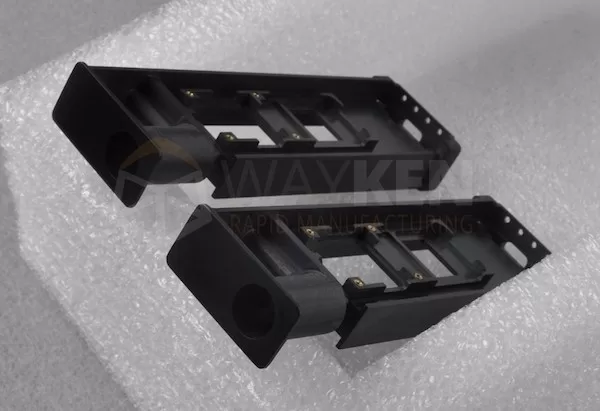Carbon fiber-reinforced PEEK material, with added carbon fibers, significantly improves its wear resistance and mechanical properties, making it an exceptional specialty engineering plastic. In plastic machining services, the high wear resistance and outstanding mechanical properties of PEEK make it widely used in airtight seals and support positioning components.
However, when providing plastic machining services, there are three major challenges in turning PEEK materials:
- Using carbide tools results in extremely poor tool life.
- It is difficult to effectively ensure the dimensional accuracy and surface roughness of parts during processing, leading to poor quality stability.
- The turning process has low efficiency, and the cutting parameters need optimization.
PCD (polycrystalline diamond) tool materials offer advantages such as tightly bonded particles, high resistance to damage, and excellent wear resistance. As turning tools, they can achieve large rake and clearance angles, reducing cutting forces, and are suitable for processing non-metallic materials.
1.PCD Tool
The general PCD tool consists of metal tool, PCD patch and bonding layer, the quality of the PCD tool is mainly determined by the grinding quality of the PCD patch and the quality of the material of the PCD patch. According to the size of the diamond particles that make up the material will be commonly used PCD material is divided into 20, 30 and 30M levels. The larger the grain size, the larger the material grade. Similar to the size of cemented carbide granularity, the larger granularity of wear resistance is better, suitable for processing harder materials.
2. Tool Selection
According to the processing of different grades of PEEK materials to choose processing tools, generally can choose YW1 or YW2 general-purpose carbide knife, can choose diamond knife better. The hardness and rigidity of high-speed steel (white steel cutter) are too low, and it is easy to wear out.
Carbide inserts are prone to front face crescent pit wear, back face wear and groove wear during machining. In the preliminary stage of tool wear, the edge is prone to chipping due to the extrusion of carbon fiber; the front face coating is rapidly broken under the friction of carbon fiber material, and the blade matrix undergoes rapid wear, resulting in a further reduction in the edge strength, and the cutting edge breakage is aggravated; in the stage of intense wear, the tool’s rear face is severely worn, and the tip arc shape is broken, resulting in a decrease in the machining accuracy of the parts, and the phenomenon of flanging and burring is serious, and the surface quality cannot be The surface quality cannot be guaranteed.
After using PCD polycrystalline diamond tools, the tool wear situation has been effectively improved. Under the same machining time and cutting conditions, only the front face of the insert is worn to a low degree, and the edge is basically intact. The arc shape of the tool tip maintains high precision, and the machining accuracy of the parts is greatly improved.
3. Analysis of Dimensional Accuracy Errors in Machining
- Impact of Cutting Force on Wear-Resistant Ring Machining
During the machining process, if the CNC program is compiled according to the normal dimensions of the wear-resistant ring, it is found that the inner hole shape and outer circular shape of the part have a taper after machining: within a length of 10-12mm, the inner hole variation is 0.04-0.05mm, and the outer circular variation is 0.01-0.03mm.
The reason for this is the low rigidity at the mouth of the part, causing tool deflection during the cutting process. Through machining adjustments, compensating for the taper in the CNC program ensures better machining accuracy. Trial machining indicates a direct correlation between the tool deflection at the mouth of the inner hole and the axial length of the part. As the axial dimension increases, the deformation at the hole mouth also increases. Compensating for the taper during programming effectively improves part machining accuracy.
- Impact of Tool Wear on Part Dimensional Accuracy and Surface Quality
Tool wear increases the cutting force, which in turn affects the dimensional accuracy and surface quality of the part. It is essential to timely adjust the tool compensation values and the CNC program to ensure the parts meet quality standards.
4.Cutting Parameters
Reasonable choice of cutting dosage, cutting dosage in the greatest impact is the amount of draft, so cutting thin-walled sets should reduce the amount of draft and reduce the cutting speed. Turning PEEK material when the appropriate increase in the front angle can make the knife sharp, smooth chip removal, reduce cutting and sassafras between the front face, reduce the cutting force and cutting heat.
5. Machining Thin-Walled Parts
When machining, coolant must be used to reduce wear and heat conduction; otherwise, the high temperatures generated by the friction between the tool and the product’s end face can cause the material to melt. In creating engineering prototypes, especially when machining thin-walled parts, their low rigidity and weak strength mean that clamping them directly with a three-jaw chuck can easily cause deformation, increasing shape errors and compromising the part’s roundness.
Therefore, when machining thin-walled parts, it is advisable to use methods such as split sleeves or spring collets for clamping. Alternatively, the clamping force direction can be changed from radial to axial clamping by using clamping tools like pressure plates.




